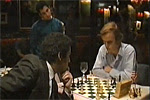BtM 39A: Beat Gazza (Beat the Amateurs I)
Position G, December 1988
White to play
Kasparov - Wolff, New York Clock Simul 1988
Contributions to the comments box are welcome. I’ll reply with what the Masters have to say about their choice to anybody who suggests a move.
Scroll down to see some commentary from me as well as feedback from the Amateurs and the Masters.
.
.
.
.
.
.
.
.
.
.
.
.
.
.
.
.
.
.
.
.
This position comes from a famous clock simul that Kasparov gave against a team of leading American juniors back in 1988.
This was the one when Gazza got the right hump when Edelman takes a draw by repetition in the opening. In the video you can hear him having a big whine about it and Patrick Wolf - his opponent in today’s position - loudly shushing him as a result.
Kasparov still had the arse the following day and had to be talked into signing Edelman's scoresheet. Something to remember next time you hear him wanging on about world politics or something important.
Wolf tells the story in his Perpetual Chess interview and the TV programme is well worth checking out on youtube even though and the sound goes haywire halfway through one of the clips and another part is missing entirely.
Anyway, on to the analysis.
I thought this was a really interesting position. It’s a relatively rare example of a defensive BtM position.
What’s more, it’s also the only position in the series I’ve seen so far where neither the panel nor the player in the game scored the 10 point answer.
Kasparov’s move was Rac1. Later he would call it a poor practical choice. It still scores 6 points. The similar Rfc1 gets 7.
What the amateurs went for:-
ME: 1 Nf3 (10)
PHIL: 1 h5 (0)
ANGUS: 1 Nf3 (10)
JUSTIN: 1 f3 (8)
MATT: 1 f3 (8)
I should say that although I got 10 points I missed the key detail at the end of the line. More of that later.
JUSTIN: "Is there any alternative to 1 f3?" Why yes there is, although MATT agreed with him in wanting to push his f-pawn. PHIL disagreed - "just ugly" - and only Horner of the Masters made this choice.
I’d considered 1 f3, only expecting gxh4, 2 fxg4 quickly concluding - correctly - that White was doing well or 1 f3 Ne5 which I incorrectly assessed as "looks dubious."
MATT also thought 1 … Ne5 was the response but HIARCS prefers … Nf6 when the position is tense rather than much better for White.
PHIL was the unlucky participant today, with his imaginative (after only three-minutes’ thought) 1 h5 intending … Qxh5, Rfd1 "I think black doesn't have a sufficient mating attack". He’s right too.
1 h5 seems to be just as good as 1 f3 but none of the panel chose it so it secures 0 points.. I must admit the idea had not occurred to me at all. Burning a tempo to gain a tempo to move a rook away to break the mating net is very clever.
Other than HORNER, the entire panel - probably aware of the source game - went for moving one or other of the rooks to c1. Nobody chose 1 Nf3. Which not only seems to be OK but seems to leave White clearly on top.
The very first line I looked at was 1 Nf3 gxh4, 2 Nxh4 Bxh4, 3 gxh4 Qxh4 but then I considered 4 Re1 which I believed lost (it does but not for the reason I’d thought).
I tried some other things - 1 f3, 1 Ne3 - and not liking them I ended up back at 1 Nf3.
I briefly thought 4 Nf6+ would exploit the pinned knight, but then realised 4 … Qxf6 is plenty good enough because Bc8 covers Ng4. 4 Rd1? - no better than Re1.
So then I tried 1 Nf3 gxh4, 2 gxh4 Bxh4 and 3 Nb6
Totally missing 3 … Bxf2+ (game over), I 'worked out' if 3 … axb6 I take the rook and I’m fine or if 3 … Rb8 I take on c8 and then on g4 and I’m winning.
Both decent assessments but aside from the check on f2 I’d also overlooked Black can just play 3… Qxb6 when I can take on h4 but White’s not at all better and will struggle even to claim equality.
ANGUS produced a thorough accurate analysis and, unlike me, fully deserved his 10 points.
After 1 Nf3 gxh4, 2 Nxh4 Bxh4, 3 gxh4 Qxh4 Angus saw 4 Qf4! which defends h2.
White is not getting mated and so, with the centralised knight, is better. Simple and yet very difficult to see in advance.
.
.
.
.
.
.
.
.
.
.
.
.
.
.
.
.
.
.
.
.
POINTS
10: Nf3
8: f3
7: Rfc1
6: Rac1
MASTERS
Nf3: None.
Rfc1: P. Littlewood, Plaskett, K. Arkell, Pein, Botterill
Rac1: Conquest, Levitt, Davies, Flear, Howell, J. Littlewood
SOURCE
Kasparov - Wolff New York Clock Simul 1988, Rac1





Since writing this post I discovered that the whole Kasparov - Wolf game has been analysed by KingCrusher on his Youtube channel
ReplyDeletehttps://www.youtube.com/watch?v=smzyecfMRds&t=294s
The analysis of the current position starts at around 4:00